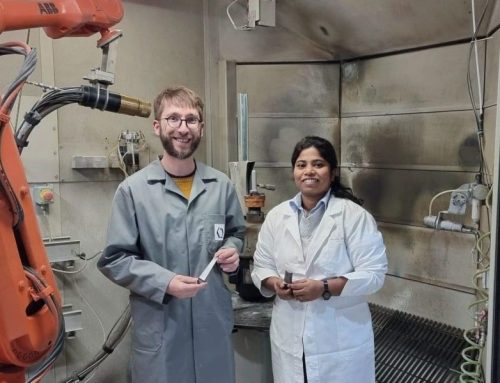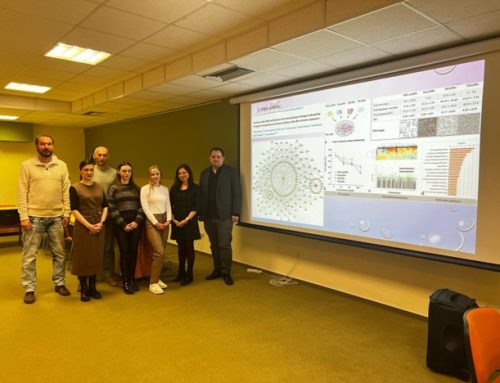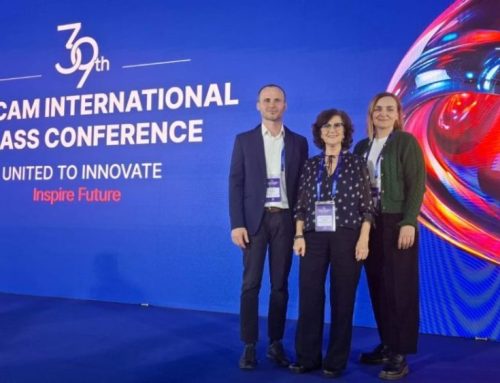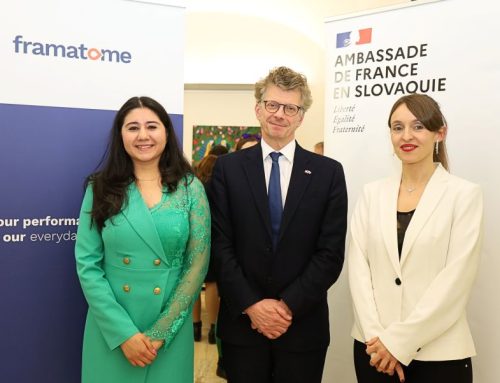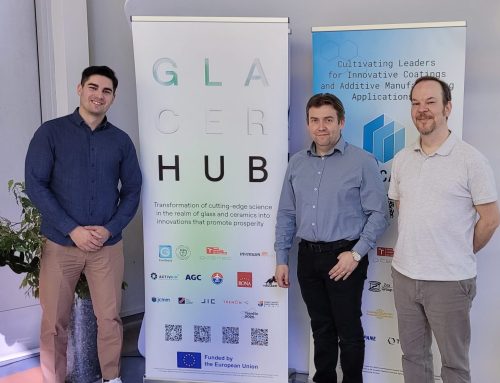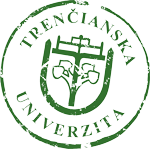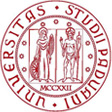Approval of FunGlasss projects by SRDA
We are pleased to announce that more FunGlass projects have been approved, this time by the Slovak Research and Development Agency (SRDA/ APVV). A total of four projects received funding from the Agency’s grant, and in three of them A. Dubček University of Trenčín (TnUAD) acts as the main organising institution. In the remaining project, TnUAD is listed as a co-organiser. Following is the overview of the three main projects with their summaries and authors:
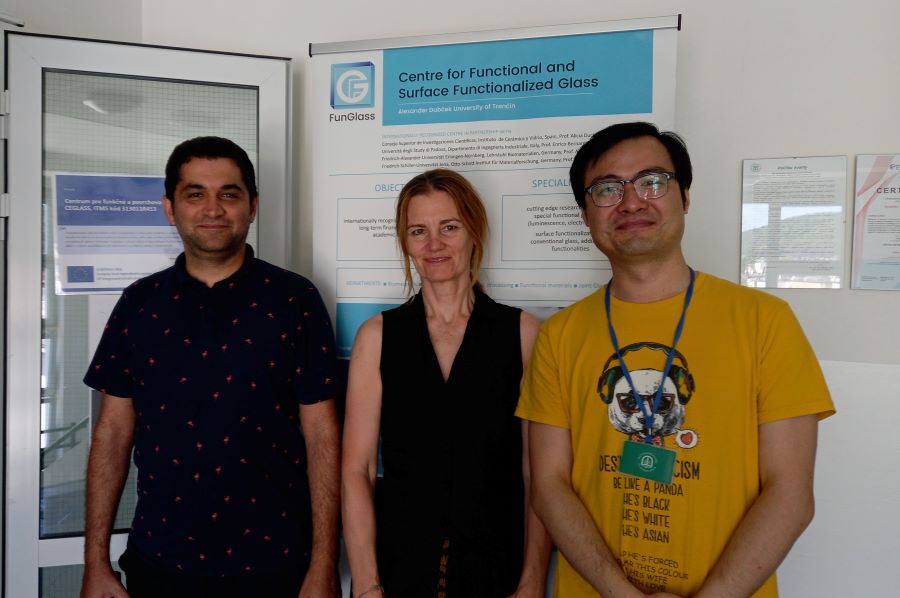
From left: Assoc. Prof. A. Pakseresht, Dr. D. Galusková, Dr. S. Chen
APVV 22-0036 3D bioactive glass scaffold mimicking natural bone with therapeutic effects for bone tissue applications
Principal Investigator: Dr. Si Chen
Yearly number of patients worldwide with osteonecrosis and bone defects caused by dis- ease and accidental injury require a scaffold implant to help regenerate the affected bone. Bioactive glass is an excellent bone repair material applied in clinical practice. Despite its remarkable features, it is mainly used in the free powder form or as a filler in dental applica- tions. The proposed project aims to fabricate hierarchical porous bioactive glass scaffolds mimicking natural bone for bone regeneration. In this respect, we will focus on mimicking the cancellous and cortical bone into one implant. The combination of micron-pore bioac- tive glass microspheres, bioactive nanoparticles and 3D additive manufacturing, is expected to construct hierarchical porous scaffolds with highly interconnected millimetre and sub- millimetre pores (300-1600 µm) and oriented micron pores (1-100 µm) as well as nanopores. The chemical compositions of the bioactive glasses, a ratio of microspheres/nanoparticles, the topology of the pore system, and sintering conditions will be investigated with aim of obtaining required mechanical properties, higher efficiency of angiogenesis, osteogenesis and cellular infiltration. Microspheres/nanoparticles are going to be modified by therapeu- tic ions e.g. boron, cobalt, zinc, cerium and copper, with a focus on biological functions promoting angiogenesis, antibacterial and immunomodulation effects.
APVV 22-0062 Reference glasses for analysis of strategic raw materials
Principal Investigator: Dr. Dagmar Galusková
Proper and detailed fundamental characterization of materials to address their physico- chemical properties is inevitable in research studies and the implementation of environ- mentally friendly technologies. Usable materials include strategic raw materials, which are the basis of new technologies and energy resources. The determination of the precise elemental composition, as well as the detection of possible contaminants, is an integral part of the mineral exploration, prospecting, processing, and industrial use of these raw materials. Chemical analysis requires a suitable analytical method and its proper use. One of the methods that is growing in popularity for the analysis of geological samples is the method of laser ablation with inductively coupled plasma mass spectrometry (LA-ICP- MS). It allows direct analysis of solid material without prior decomposition and enables to characterize the sample not only in terms of its bulk composition but also in terms of microstructure, individual mineral grains, zoning, migration of elements, etc. For proper use of this method, a suitable calibration standard is needed with the analyte contents as close as possible to the sample analyzed. The market for commercially available calibration standards is very limited, so in many cases, the situation is solved by the preparation of calibration materials in the laboratory. For the standard to meet the conditions necessary for LA-ICP-MS and professional approach and knowledge are required. The project will cover development and preparation of reference materials applicable for laser ablation ICP- MS analysis covering a wide concentration range of elements detected in most important strategic raw materials.
APVV 22-0070 Synthesis and developing of high entropy oxide ceramic for thermal barrier application
Principal Investigator: Assoc. Prof. Amirhossein Pakseresht
Barrier coatings (TBCs) are currently used to provide thermal insulation against hot gasses in advanced gas turbines and diesel engines in order to improve their performance and effi- ciency of these machines. TBC coatings typically consist of a creep-resistant, high strength Ni-based superalloy as a substrate, an oxidation resistant bond coat (BC), and a ceramic topcoat (TC) of Yttria-stabilized zirconia (YSZ). Nowadays, fluorite oxides have been pro- posed as a new TBC coating with a lower thermal conductivity and a higher thermal expansion coefficient compared to conventional coating. However, its thermal expansion undergoes a sudden decrease in the range of 200—400 ◦C and it has poor mechanical prop- erties resulting in short thermal cycling lifetime in the case of this new coating. To solve mentioned problem and increase TBCs efficiency and life span, in this work, high entropy fluorite oxide as a new kind of material will be introduced as a new TBC to enhance the thermal and mechanical properties of conventional ones. The concept of the new category materials high entropy ceramics (HECs) has been proposed several years ago, which is directly borrowed from high entropy alloys (HEAs). High-entropy ceramics is an emerg- ing class of high-entropy materials with higher properties in comparison with conventional ones. It leads to new materials, both as bulk and films, play important roles in technol- ogy in the decades to come. This work will focus on the processing and characterization of high-entropy powder ceramics, it means, the composition design, structure, chemistry, composite processing of powder, and evolution of microstructure and properties will be investigated. In the second stage, the bulk samples will be synthesized by spark plasma sintering or hot-pressing method to produce high entropy bulk ceramics. Then, all the samples will be characterized. The optimized sample with the higher properties will be granulated to use for thermal barrier application.
Overview of the co-organised project is following:
APVV 22-0004 Influence of radiation load on fiberglass insulation in terms of refrigerant recirculation in emergency conditions of nu- clear power plants with pressurized water reactors
Principal Organiser: VÚEZ, a.s
The aim of the Project is to extend the methodology of verifying the functional capability of emergency core cooling systems in case of loss-of-coolant accidents as well as that of cooling systems intended for severe accidents from the standpoint of impacts of long-term exposure of thermal insulation to radiation at elevated temperatures and in such a way to actively contribute to increasing the operating safety of nuclear power plants. Within the Project, samples of thermal insulation exposed to accelerated heat and radiation ageing will be investigated. The radiation doses are anticipated to be at the level of a 40-year operation at a dose rate of 10 Gy/h on the primary circuit of a WWER 440 V213 type NPP. Samples treated in such a way will be investigated from the standpoint of changes in their physico- mechanical properties as well as from the standpoint of their chemical resistance to corrosive effects of emergency reactor coolant. However, preparation of the samples by accelerated heat and radiation ageing is extremely both time-consuming and costly. For instance, to obtain a sufficient radiation dose at a level simulating a 40-year operation (approximately 3500 kGy), irradiation period is needed equal to approximately 1650 h of net irradiation time with an average irradiation dose rate of 2 kGy/h. Irradiation is to be performed at an elevated temperature of 300 ◦C which means that it will have to be performed in a thermal box. That is why it is necessary to develop a procedure for simulation of irradiation effects in order to obtain a sufficient number of samples for integrated testing. A feasible solution seems to be thermo-mechanical loading of the samples since, based on the knowledge obtained so far, thermal insulation fibres under the effect of irradiation at elevated temperature lose their mechanical elasticity and become brittle. In addition, their


